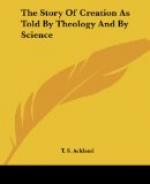“And there was evening and there was morning, the sixth day.”
The terms in which the Creation of man is spoken of are such as to challenge particular attention and to induce us to expect something very different from what occurred on any previous occasion. In the first place, more agents than one are introduced by the use of the plural form of the verb, and thus at the very commencement of man’s career there is an intimation of that mysterious fact of the Trinity in Unity which was to have so important an influence upon his future destiny. Then we are told that man was to be formed in the Image of God, a statement which probably is of very wide import. It has been variously interpreted as having reference to the spiritual, moral, and intellectual nature of man; to the fact that the nature of man was afterwards to be assumed by the Second Person of the Trinity; to the delegated empire of this world which man was to hold. There are two expressions of St. Paul: that “man is the image and glory of God” (1 Cor. xi. 7), and that “the invisible things of Him from the creation of the world are clearly seen, being understood by the things that are made, even His eternal Power and Godhead” (Rom. i. 20), which seem to indicate that this record has a significance which as yet we can only partially understand. Then the story of man’s creation is repeated in the second chapter, and while the other events recorded in the first chapter are very briefly summarized, that of man is very much amplified. This does riot necessarily indicate an independent account, as is sometimes asserted; at the fourth verse of the second chapter a distinct portion of revelation commences—the special dealing of God with man, and this could not be intelligible without an amount of detail with reference to man’s origin, which would have been out of place in the short account of the origin of the world by which it is preceded. In this account the creation of Adam and Eve is recorded as two separate events, the latter of which is described in terms of deep mystery, of which all that we can say is that they point to that still deeper mystery—the birth of the Bride— the Lamb’s Wife from the pierced side of the Lamb. But in the case of Adam there is a remarkable difference from anything that has gone before. Two distinct acts of creation are recorded; one of which places man before us in his physical relation to the lower animals, while the other treats of him in his spiritual relation to his Maker. “The Lord God formed man (the Adam) dust from the ground (adamah), and breathed into his nostrils the breath of lives; and man became a soul of life.” The inspiration of the “breath of lives” distinguishes the creation of man from that of all other creatures.




